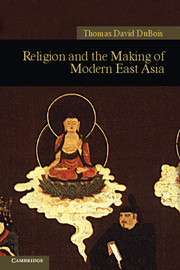Book contents
- Frontmatter
- Contents
- List of Boxes, Figures, and Maps
- Preface
- 1 In the beginning: Religion and history
- 2 Ming China: The fourteenth century's new world order
- 3 The Buddha and the shōgun in sixteenth-century Japan
- 4 Opportunities lost: The failure of Christianity, 1550–1750
- 5 Buddhism: Incarnations and reincarnations
- 6 Apocalypse now
- 7 Out of the twilight: Religion and the late nineteenth century
- 8 Into the abyss: Religion and the road to disaster during the early twentieth century
- 9 Brave new world: Religion in the reinvention of postwar Asia
- 10 The globalization of Asian religion
- Glossary
- Timeline of dynasties and major events
- Suggestions for further reading
- Index
6 - Apocalypse now
Published online by Cambridge University Press: 05 June 2012
- Frontmatter
- Contents
- List of Boxes, Figures, and Maps
- Preface
- 1 In the beginning: Religion and history
- 2 Ming China: The fourteenth century's new world order
- 3 The Buddha and the shōgun in sixteenth-century Japan
- 4 Opportunities lost: The failure of Christianity, 1550–1750
- 5 Buddhism: Incarnations and reincarnations
- 6 Apocalypse now
- 7 Out of the twilight: Religion and the late nineteenth century
- 8 Into the abyss: Religion and the road to disaster during the early twentieth century
- 9 Brave new world: Religion in the reinvention of postwar Asia
- 10 The globalization of Asian religion
- Glossary
- Timeline of dynasties and major events
- Suggestions for further reading
- Index
Summary
Why the world keeps ending
If you want a happy ending, that depends, of course, on where you stop your story.
– Orson WellesSeen from a global perspective, October 23, 1844, was not an especially eventful day. The world was remarkably, if atypically peaceful. England was beginning what would be the long reign of Queen Victoria, and the United States just ending the profoundly uneventful presidency of John Tyler. No wars were fought: the only shadow of conflict was that looming between Mexico and what was for not much longer to be the independent Republic of Texas. Karl Marx had just met Friedrich Engels and completed one of his minor works. Charles Dickens had recently published the final installment of the serial novel Martin Chuzzlewit. Although not newsworthy at the time, the actress Sarah Bernhardt was born in Paris on this day. The lead story in the London daily Times concerned the upcoming visit of the Queen to the city, including helpful hints of where to stand for the best view of the royal procession. Nearly one whole page was devoted to a long, indignant letter from one member of the public who questioned the wisdom of forcing women in workhouses to break stones for a living. It was something of a slow news day.
But for a hundred thousand followers of the preacher William Miller, October 23 presented a very serious problem – it should not have arrived at all.
- Type
- Chapter
- Information
- Religion and the Making of Modern East Asia , pp. 123 - 141Publisher: Cambridge University PressPrint publication year: 2011

